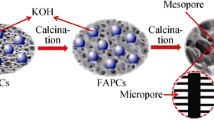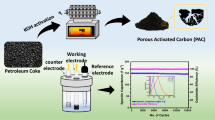Abstract
Activated porous carbon that employed as supercapacitor electrode was synthesized through a controlled carbonization–activation process of Ethynyl phenyl azo phenol-biphenylene resin. Nitrogen adsorption test, scanning electron microscopy (SEM) and elemental analysis were used to characterize the microstructure and microtopography of the activated porous carbon. As a result, the porous carbon treated with CO2-2h showed a high specific surface area of 2152.48 m2/g and a high specific capacitance of about 62.33 F/g at a current density of 0.1 A /g, which indicates the promising potential of as-prepared porous carbon for solid symmetric supercapacitor. The porous carbon treated with CO2-2h exhibited a high specific capacitance of 62.33 F/g at 0.1 A/g, and good rate capability of 82.16% retention from 0.1 to 2 A/g. It showed that activated porous carbon can obtain higher specific surface area and contribute to desirable microstructure and electrode materials with excellent electrochemical performance. The excellent energy storage ability of the activated porous carbon is ascribed to the high conductivity and high storage ability of amorphous carbon with variable pore size and distribution. The high specific capacitance and long cycle stability makes it an anticipative candidate to attain the urge for the establishment of new functional materials for energy storage.
Graphical abstract




Similar content being viewed by others
References
Zhang Y, Yao QQ, Gao HL et al (2014) Facile synthesis and electrochemical performance of manganese dioxide doped by activated carbon, carbon nanofiber and carbon nanotube[J]. Powder Technol 262:150–155
Wilson BE, He S, Buffington K et al (2015) Utilizing ionic liquids for controlled N-doping in hard-templated, mesoporous carbon electrodes for high-performance electrochemical double-layer capacitors[J]. J Power Sour 298:193–202
Liang Z, Xia H, Zhang L et al (2020) One-pot synthesis of monodisperse phenolic resin spheres with high thermal stability and its derived carbon spheres as supercapacitor electrodes[J]. Results in Physics 16:102912
Zang J, Tian P, Yang G et al (2019) A facile preparation of pomegranate-like porous carbon by carbonization and activation of phenolic resin prepared via hydrothermal synthesis in KOH solution for high performance supercapacitor electrodes[J]. Adv Powder Technol 30(12):2900–2907
Xu B, Wu F, Chen S et al (2007) Activated carbon fiber cloths as electrodes for high performance electric double layer capacitors[J]. Electrochim Acta 52(13):4595–4598
Chen L, Li D, Chen L et al (2018) Core-shell structured carbon nanofibers yarn@polypyrrole@graphene for high performance all-solid-state fiber supercapacitors[J]. Carbon 138:264–270
Zhang J, Zhao XS (2012) Conducting polymers directly coated on reduced graphene oxide sheets as high-performance supercapacitor Electrodes[J]. J Phys Chem C 116(9):5420–5426
Ruibin Q et al (2015) Monodisperse carbon microspheres derived from potato starch for asymmetric supercapacitors. Electrochim Acta 167:303–310
Xia K, Gao Q, Jiang J, Hu J (2008) Hierarchical porous carbons with controlled micropores and mesopores for supercapacitor electrode materials. Carbon 46(13):1718–1726
Li Y, Li Z, Zheng F (2015) Polyaniline/Silver/Cerium nitrate ternary composite: synthesis, characterization and enhanced electrochemical properties [J]. J Appl Polym Sci 132:13250–13256
Sadeghinia M, Shayeh JS, Fatemi F et al (2019) Electrochemical study of perlite-barium ferrite/conductive polymer nano composite for super capacitor applications[J]. Int J Hydrogen Energy 44(52):28088–28095
Wang CH, Wen WC, Hsu HC et al (2016) High-capacitance KOH-activated nitrogen-containing porous carbon material from waste coffee grounds in supercapacitor[J]. Adv Powder Technol 27:1387–1395
Mori T, Iwamura S, Ogino I et al (2019) Cost-effective synthesis of activated carbons with high surface areas for electrodes of non-aqueous electric double layer capacitors[J]. Sep Purif Technol 214:174–180
Arnaiz M, Nair V, Mitra S et al (2019) Furfuryl alcohol derived high-end carbons for ultrafast dual carbon lithium ion capacitors[J]. Electrochim Acta 304:437–446
Li Z, Li Y, Li J et al (2019) Synthesis and thermal properties of ethynyl phenyl azo phenol-biphenylene resin[J]. ACS Omega 4(1):1–8
Jiang Qi Lu, Xiao-Ying ZY et al (2004) Effect of the amount of F4 Fluoroplastic binder in carbon electrodes on charracteristics of supercapacitors[J]. Rus J Appl Chem 20(5):546–549
Neetu T, Jung SH, Le TH et al (2020) Phenol-formaldehyde-resin-based activated carbons with controlled pore size distribution for high-performance supercapacitors[J]. Chem Eng J 379:122332
Author information
Authors and Affiliations
Corresponding author
Additional information
Publisher's Note
Springer Nature remains neutral with regard to jurisdictional claims in published maps and institutional affiliations.
Rights and permissions
Springer Nature or its licensor (e.g. a society or other partner) holds exclusive rights to this article under a publishing agreement with the author(s) or other rightsholder(s); author self-archiving of the accepted manuscript version of this article is solely governed by the terms of such publishing agreement and applicable law.
About this article
Cite this article
Deng, X., Li, J., Liu, M. et al. Activated porous carbon derived from ethynyl phenyl azo phenol-biphenylene resin for high-performance supercapacitor. Polym. Bull. 80, 11107–11119 (2023). https://doi.org/10.1007/s00289-022-04577-5
Received:
Revised:
Accepted:
Published:
Issue Date:
DOI: https://doi.org/10.1007/s00289-022-04577-5




